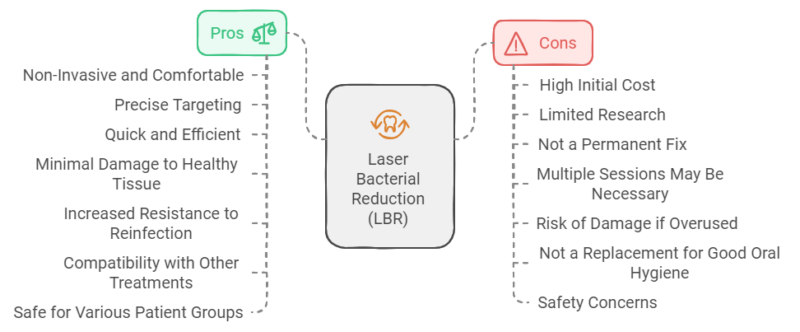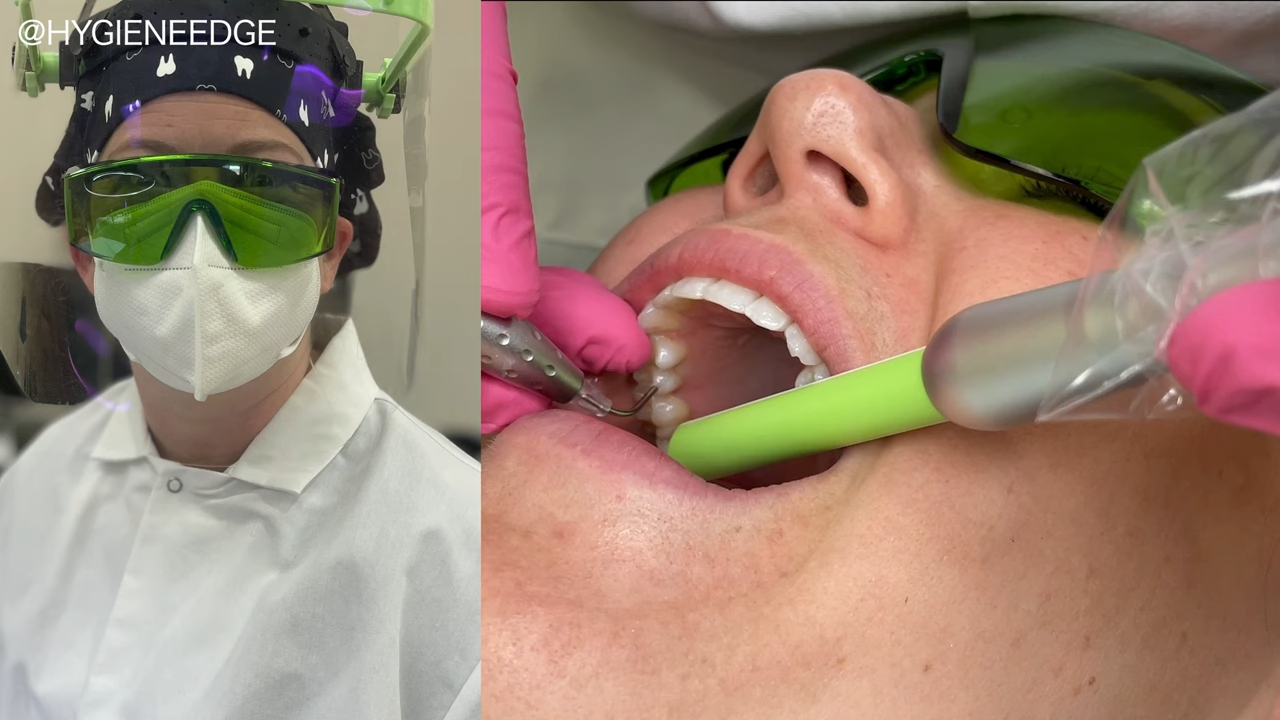Picture a tiny, powerful beam of light targeting bacteria lurking in your mouth. That’s essentially what LBR does. The laser used operates in the visible red or infrared spectrum. It targets bacterial cells by converting light into heat, effectively destroying harmful bacteria without disturbing the surrounding healthy tissue.
How Does It Work?
The laser’s wavelength is absorbed by the pigments in bacterial cells, heating them up and eliminating the bad guys while leaving your healthy tooth structure untouched. This precision makes it a valuable tool for tackling infections in a way traditional methods sometimes struggle with.
Pros of Laser Bacterial Reduction

LBR has several strong points that make it appealing, especially for those dealing with chronic or severe oral health issues.
1. Non-Invasive and Comfortable
One of the most significant benefits is that it’s non-invasive. There’s no drilling, no scraping—just a beam of light doing its job. If you’re someone who dreads the dental chair, this can be a much more comfortable option. Plus, the procedure often doesn’t require anesthesia, making it even more convenient.
2. Precise Targeting
3. Quick and Efficient
LBR doesn’t take long to perform, and recovery time is minimal. You could potentially get treated and be back to your day without much downtime. The speedy nature of the procedure is a plus for those with busy schedules.
4. Minimal Damage to Healthy Tissue
5. Increased Resistance to Reinfection
An added bonus is that treated areas might be more resistant to bacteria trying to make a comeback. This can be particularly helpful if you’re prone to infections or have areas in your mouth that are hard to keep clean.
6. Compatibility with Other Treatments
LBR can be used alongside other dental treatments. For example, it can be a preparatory step before getting a filling or crown, ensuring the area is thoroughly disinfected before any work begins.
7. Safe for Various Patient Groups
Cons of the Treatment

1. High Initial Cost
The equipment for LBR can be expensive, with prices ranging from $15,000 to $100,000. Because of this, the cost of the procedure itself can be higher compared to traditional treatments. Plus, many insurance plans don’t cover it, which could leave you footing the bill.
2. Limited Research
3. Not a Permanent Fix
LBR isn’t a one-time cure. Bacteria can and will repopulate if you don’t maintain good oral hygiene. So, while it’s an effective tool, it’s not a substitute for brushing, flossing, and regular dental visits.
4. Multiple Sessions May Be Necessary
5. Risk of Damage if Overused
If not used correctly, there’s a risk of damaging healthy tooth structure. This means it’s crucial to have a trained and experienced dentist handling the procedure.
6. Not a Replacement for Good Oral Hygiene
7. Safety Concerns
LBR involves lasers, which means safety protocols are a must. Improper use could lead to risks like eye damage or inhalation of vaporized tissue. It’s essential that your dental team is well-trained and follows strict safety guidelines.
Who Could Benefit from Laser Bacterial Reduction?

LBR isn’t for everyone, but certain groups of people may find it particularly beneficial.
| Condition | Description |
| Resistant Periodontitis | LBR can help when traditional treatments for periodontitis fail. |
| Peri-Implantitis | Safe around dental implants, manages infections without compromising the implant. |
| Immunocompromised Patients | Provides a safer option for those with weakened immune systems, avoiding more invasive treatments. |
| Pediatric or Anxious Patients | Less intimidating for patients with dental anxiety, including children, due to no drilling or scraping. |
| Hopeless Teeth and Pre-Restorative Disinfection | Useful for disinfecting areas before extractions or restorations, and for severely damaged teeth. |
What to Ask Your Dentist About the Treatment
If you’re thinking about LBR, it’s smart to have a chat with your dentist first. Here are some questions to get you started:
- What type of laser do you use, and for which procedures?
- How does the cost compare to conventional treatments?
- How many sessions will I need, and how long will the effects last?
- What are the potential side effects?
- Are there equivalent conventional treatments that might work just as well?
The Bottom Line
Laser bacterial reduction offers a promising way to tackle stubborn oral infections. It’s non-invasive, precise, and generally safe for a variety of patients. However, the high cost, need for specialized training, and limitations in current research mean it’s not for everyone.
For mild conditions or those well-managed by traditional methods, it might not be necessary. But for those struggling with recurrent issues or specific conditions like periodontitis or per-implantitis, it could be a game-changer.

